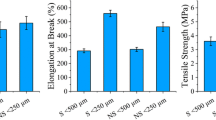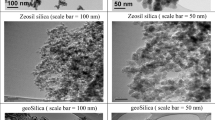Abstract
In this paper, walnut shell filler of 75–150 µm and 45–75 µm size was used in rubber compound with different loadings (2,3, and 5 phr). At 2, 3, and 5 phr loading, small-size WNS powder (45–75 µm) has higher modulus at 300%, tensile strength and elongation at break than larger-size powder (75–150 µm); however, modulus at 300% is lower than blank compound. As the amount of WNS filler increases, the elongation at break with modulus at 300% and tensile strength decrease. The goal of using silane is to improve the interfacial interaction between WNS filler and the rubber matrix. Larger-size WNS filler using Si69 compound demonstrated higher modulus at 300% with higher elongation at break and tensile strength compared to non-silanised compound; however, modulus at 300% remained lower than blank compound. The silanised compound with both WNS fillers demonstrated slightly higher rebound resilience at 100 °C, slightly lower heat build-up, and slightly lower tan delta at 60 °C than the blank compound. It was demonstrated that small-size WNS filler with silane could partially replace N330 carbon black (3 phr) in natural rubber-based tire tread compound due to its bio-based, biodegradable, renewable and sustainable properties.











Similar content being viewed by others
Data availability
The authors confirm that the data supporting the findings of this study are available within the article.
References
Singha A, Thakur VJIJOPM (2008) Synthesis and characterization of Grewia optiva fiber-reinforced PF-based composites. Int J Polym Mater Polym Biomater 57:1059–1074. https://doi.org/10.1080/00914030802257800
Tangboriboon N, Takkire R, Sangwan W, Sirivat A (2019) bio-CaCO3 from raw eggshell as additive in natural rubber latex glove films. Rubber Chem Technol 92:558–577
Thakur V, Singha A, Thakur MK (2012) Graft copolymerization of methyl acrylate onto cellulosic biofibers: synthesis, characterization and applications. J Polym Environ 20:164–174
Thakur VK, Singha AS, Kaur I, Nagarajarao RP, Liping Y (2010) Characterization, silane functionalization of Saccaharum cilliare fibers: thermal, morphological, and physicochemical study. Int J Polym Anal Charact 15:397–414
Arayapranee W, Na-Ranong N, Rempel GL (2005) Application of rice husk ash as fillers in the natural rubber industry. J Appl Polym Sci 98:34–41
Kazemi H, Mighri F, Park KW, Frikha S, Rodrigue D (2022) Technology, effect of cellulose fiber surface treatment to replace carbon black in natural rubber hybrid composites. Rubber Chem Technol 95:128–146
Parmar BS, Chauhan NPS, Deuri AS, Vaidya D, Chundawat NS (2023) Study of physico-mechanical and dynamic mechanical properties of rice husk silica rubber compound replacing carbon black as a sustainable filler. AIP Conf Proc 2715:020032
Zhou Y, Fan M, Chen L, Zhuang JJCPBE (2015) Lignocellulosic fibre mediated rubber composites: an overview. Compos Part B Eng 76:180–191
Pirayesh H, Khazaeian A, Tabarsa T (2012) The potential for using walnut (Juglans regia L.) shell as a raw material for wood-based particleboard manufacturing. Compos Part B Eng 43:3276–3280
Balaji N, Jayabal SJPOTIOME (2016) Artificial neural network modeling of mechanical behaviors of zea fiber–polyester composites. Part E J Process Mech Eng 230:45–55
Orue A, Eceiza A, Arbelaiz A (2020) Products, the use of alkali treated walnut shells as filler in plasticized poly (lactic acid) matrix composites. Ind Crop Prod 145
Zahedi M, Pirayesh H, Khanjanzadeh H, Tabar MM (2013) Design, organo-modified montmorillonite reinforced walnut shell/polypropylene composites. Mater Design 51:803–809
Miedzianowska J, Masłowski M, Rybiński P, Strzelec K (2020) Properties of chemically modified (selected silanes) lignocellulosic filler and its application in natural rubber biocomposites. Materials 13:4163
Sowińska-Baranowska A, Maciejewska M, Duda P (2022) The potential application of starch and walnut shells as biofillers for natural rubber (NR) composites. Int J Mol Sci 23:7968
Ansarifar A, Wang L, Ellis R, Kirtley S, Riyazuddin N (2007) Enhancing the mechanical properties of styrene–butadiene rubber by optimizing the chemical bonding between silanized silica nanofiller and the rubber. J Appl Polym Sci 105:322–332
Ming PTS, Bao CA, Kamaruddin S (2020) The potential of oil palm ash and eggshell powder as hybrid biofillers in natural rubber biocomposites. In: IOP conference series: materials science and engineering. IOP Publishing, p 012013
Roy K, Debnath SC, Tzounis L, Pongwisuthiruchte A, Potiyaraj P (2020) Effect of various surface treatments on the performance of jute fibers filled natural rubber (NR) composites. Polymers 12:369
Sahu P, Gupta MJPOTIOME (2020) A review on the properties of natural fibres and its bio-composites: effect of alkali treatment. Part L J Mater Des Appl 234:198–217
Srisuwan L, Jarukumjorn K, Suppakarn N (2018) Engineering, effect of silane treatment methods on physical properties of rice husk flour/natural rubber composites. Adv Mater Sci Eng 2018:4583974
Ali A, Ali S, Yu L, Liu H, Khalid S, Hussain A, Qayum MMN, Ying C (2019) Preparation and characterization of starch-based composite films reinforced by apricot and walnut shells. J Appl Polym Sci 136:47978
El-Sabbagh A, Taha I (2013) Characterization of the draping behavior of jute woven fabrics for applications of natural-fiber/epoxy composites. J Appl Polym Sci 130:1453–1465
Haddou G, Dandurand J, Dantras E, Maiduc H, Thai H, Giang NV, Trung TH, Ponteins P, Lacabanne C (2019) Mechanical properties of continuous bamboo fiber-reinforced biobased polyamide 11 composites. J Appl Polym Sci 136:47623
Kocaman S, Ahmetli GT (2020) Effects of various methods of chemical modification of lignocellulose hazelnut shell waste on a newly synthesized bio-based epoxy composite. J Polym Environ 28:1190–1203
Kocaman S, Karaman M, Gursoy M, Ahmetli G (2017) Chemical and plasma surface modification of lignocellulose coconut waste for the preparation of advanced biobased composite materials. Carbohydr Polym 159:48–57
Mohan S, Panneerselvam K (2021) An investigation on antibacterial filler property of silver nanoparticles generated from Walnut shell powder by insitu process. Mater Today Proc 39:368–372
Hejna A, Sulyman M, Przybysz M, Saeb MR, Klein M, Formela KJW, Valorization B (2020) On the correlation of lignocellulosic filler composition with the performance properties of poly (ε-caprolactone) based biocomposites. Waste Biomass Valor 11:1467–1479
Parmar BS, Chauhan NPS, Jadoun S, Deuri AS, Vaidya D, Rahdar A, Chundawat NS (2022) Study of alkali metals and alkaline earth metals in chlorobutyl rubber-based model truck inner tube compound. Adv Ind Eng Polym Res 5:171–182
Tiber B, Balcıoğlu HE (2019) Flexural and fracture behavior of natural fiber knitted fabric reinforced composites. Polym Compos 40:217–228
Shejkar SK, Agrawal A, Agrawal B (2020) Walnut shell particulates as filler material in polymeric matrix: a review. Int J Eng Res Curr Trends 2:41–43
Orue A, Eceiza A, Arbelaiz A (2020) The use of alkali treated walnut shells as filler in plasticized poly (lactic acid) matrix composites. Ind Crops Prod 145
Jahanban-Esfahlan A, Amarowicz R (2018) Walnut (Juglans regia L.) shell pyroligneous acid: chemical constituents and functional applications. RSC Adv 8:22376–22391
Członka S, Kairytė A, Miedzińska K, Strąkowska A (2021) Polyurethane composites reinforced with walnut shell filler treated with perlite, montmorillonite and halloysite. Int J Mol Sci 22:7304
Dhiman P, Sharma H (2021) Effect of walnut shell filler on mechanical properties of jute-basalt hybrid epoxy composites. Mater Today Proc 44:4537–4541
Sowińska-Baranowska A, Maciejewska M, Duda P (2022) The potential application of starch and walnut shells as biofillers for natural rubber (NR) composites. Int J Mol Sci 23:7968
Sattayanurak S, Sahakaro K, Kaewsakul W, Dierkes W, Reuvekamp L, Blume A, Noordermeer J (2021) Elucidating the role of clay-modifier on the properties of silica-and silica/nanoclay-reinforced natural rubber tire compounds. Express Polym Lett 15(7):666–684
Sattayanurak S, Sahakaro K, Kaewsakul W, Dierkes W, Reuvekamp L, Blume A, Noordermeer J (2021) Enhancing performance of silica-reinforced natural rubber tire tread compounds by applying organoclay as secondary filler. Rubber Chem Technol 94:121–144
Chundawat NS, Parmar BS, Deuri AS, Vaidya D, Jadoun S, Zarrintaj P, Barani M, Chauhan NPS (2022) Rice husk silica as a sustainable filler in the tire industry. Arab J Chem 15
Bhattacharyya SK, Parmar BS, Mukhopadhyay R, Bandyopadhyay A (2015) Analysis of autohesion and physico-mechanical properties (multifunctional behavior) of the coagulum from the latex of euphorbia caducifolia haines VIS-À-VIS comparison against synthetic resins in natural rubber compounds. Rubber Chem Technol 88:421–436
Bhattacharyya SK, Parmar BS, Mukhopadhyay R, Bandyopadhyay A (2017) Application of the resin derived from the native Euphorbia caducifolia haines as multifunctional additive in filled natural rubber compounds. Rubber Chem Technol 90:429–444
Bhattacharyya SK, Parmar BS, Chakraborty A, Dasgupta S, Mukhopadhyay R, Bandyopadhyay A (2012) Exploring microcrystalline cellulose (mcc) as a green multifunctional additive (MFA) in a typical solution-grade styrene butadiene rubber (S-SBR)-based tread compound. Ind Eng Chem Res 51:10649–10658
Chundawat NS, Parmar BS, Deuri AS, Vaidya D, Sepehr KS, Chauhan NPS (2020) Walnut shell ash as a sustainable material for compounding with bromobutyl rubber for tire inner liner applications. Polym Compos 41:5317–5330
Ponnamma D, Sung SH, Hong JS, Ahn KH, Varughese K, Thomas SJEPJ (2014) Influence of non-covalent functionalization of carbon nanotubes on the rheological behavior of natural rubber latex nanocomposites 53:147–159
Sternstein S, Zhu A-JJM (2002) Reinforcement mechanism of nanofilled polymer melts as elucidated by nonlinear viscoelastic behavior. Macromolecules 35:7262–7273
Sattayanurak S, Sahakaro K, Kaewsakul W, Dierkes WK, Reuvekamp LA, Blume A, Noordermeer JW (2020) Synergistic effect by high specific surface area carbon black as secondary filler in silica reinforced natural rubber tire tread compounds. Polym Test 81
Hayichelaeh C, Reuvekamp L, Dierkes W, Blume A, Noordermeer J, Sahakaro K (2020) Silica-reinforced natural rubber tire tread compounds containing bio-based process oils. I: aspects of mixing sequence and epoxide content. Rubber Chem Technol 93:360–377
Meera A, Said S, Grohens Y, Thomas S (2009) Nonlinear viscoelastic behavior of silica-filled natural rubber nanocomposites. J Phys Chem C 113:17997–18002
Kazemi H, Mighri F, Park KW, Frikha S, Rodrigue D (2022) Effect of cellulose fiber surface treatment to replace carbon black in natural rubber hybrid composites. Rubber Chem Technol 95:128–146
Bindu P, Thomas S (2013) Viscoelastic behavior and reinforcement mechanism in rubber nanocomposites in the vicinity of spherical nanoparticles. J Phys Chem B 117:12632–12648
Abdalla M, Dean D, Adibempe D, Nyairo E, Robinson P, Thompson GJP (2007) The effect of interfacial chemistry on molecular mobility and morphology of multiwalled carbon nanotubes epoxy nanocomposite. Polymer 48:5662–5670
Rao PJM (2007) Mechanics of polymer–clay nanocomposites. Macromolecules 40:290–296
Kojima Y, Usuki A, Kawasumi M, Okada A, Fukushima Y, Kurauchi T, Kamigaito O (1993) Mechanical properties of nylon 6-clay hybrid. J Mater Res 8:1185–1189
Katueangngan K, Tulyapitak T, Saetung A, Soontaranon S, Nithi-Uthai N (2020) Interfacial interactions of silica and natural rubber enhanced by hydroxyl telechelic natural rubber as interfacial modifier. J Vinyl Add Technol 26:291–303
Acknowledgements
The authors are thankful to the BKT management for their kind permission to publish this work and also thanks to Mr. N. Soni, Mr. K.Vinnet, Mr. A. Chipa, Mr. K. Singh, Mr. C.K Sinha and Mr. A Tank for carry out the testing at SPIH (BKT-R&D).
Funding
This research received no specific grant from any funding agency in the public, commercial or not-for-profit sector.
Author information
Authors and Affiliations
Contributions
NSC and NPSC suggested the idea while BSP performed the experimental studies and statistical analysis. BSP, NPSC, PP and SJ wrote the manuscript while NPSC and NSC analysed the paper and interpreted the data. NSC and DV have reviewed the script. All authors discussed the data and agreed to submit the manuscript.
Corresponding author
Ethics declarations
Conflict of interest
On behalf of all authors, the corresponding author states that there is no conflict of interest.
Additional information
Publisher's Note
Springer Nature remains neutral with regard to jurisdictional claims in published maps and institutional affiliations.
Rights and permissions
Springer Nature or its licensor (e.g. a society or other partner) holds exclusive rights to this article under a publishing agreement with the author(s) or other rightsholder(s); author self-archiving of the accepted manuscript version of this article is solely governed by the terms of such publishing agreement and applicable law.
About this article
Cite this article
Chundawat, N.S., Parmar, B.S., Perumal, P. et al. Effect of walnut-shell filler as sustainable material with silane to replace carbon black in natural rubber-based tire tread compound. J Rubber Res 26, 425–439 (2023). https://doi.org/10.1007/s42464-023-00226-2
Received:
Accepted:
Published:
Issue Date:
DOI: https://doi.org/10.1007/s42464-023-00226-2




